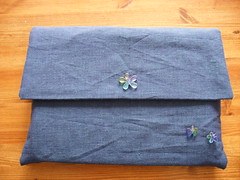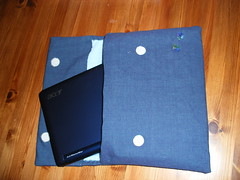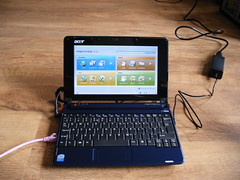The rules of the girl geek dinners is that any geeky girls can go – and not just tapping-into-a-black-screen-in-a-darkened-room geek girls, there is no minimum requirement! Guys are also welcome but they must be there as the invited guest of one of the geeks. I’m open to persuasion if anyone would like to attend as my guest – and for the girls, I’ll see you there :)
Tag Archives: tech
Opera’s Address Bar AutoCompletion
It turns out that this new behaviour is, in fact, a feature – Opera remembers the content of all the pages you’ve been to as well as just their URLs, and then it tries to give you the most relevant matches in your address bar. Well that doesn’t work for me. Address bars are for typing addresses and search engines are for searching content in my world, maybe I’ll find this useful one day but that day isn’t right now. The good news is, its easy to turn off.
Just go to Preferences -> Advanced -> History and then uncheck the box “Remember Content on Visited Pages”. Now when I start typing, I just get the URLs that look like my actual words, and with the shortest matches first. I’m safe to upgrade the other machines now!
Screen for Linux
I use a custom .screenrc file, which adds numbered labels so show which screens I have open, so I see something like this at the bottom of my screen (click on it to make it normal size, the thumbnail is somehow tiny):
My .screenrc file looks like this:
termcapinfo xterm 'hs:ts=\E]2;:fs=\007:ds=\E]2;screen\007'
termcapinfo xterm ti@:te@
shelltitle '$ |bash'
termcapinfo rxvt 'hs:ts=\E]2;:fs=\007:ds=\E]2;screen\007'
termcapinfo rxvt ti@:te@
hardstatus on
hardstatus alwayslastline
hardstatus string "%{wk}%H%{Bk}|%{Mk}%?%-Lw%?%{km}[%n*%f %t]%?(%u)%?%{mk}%?%+Lw%? %=%{Bk}"
Don’t ask me what any of it does, I got it from someone else and just copy it around machines all the time! The tabs create themselves when you create a new screen (ctrl + a, c) and then you can edit the labels with ctrl + a, A. What else can you do with .screenrc? I must confess I’ve never really looked
How to Submit a Conference Talk
The first thing to say about submitting talks, is that there are no pre-requisites. You don’t need to be published, well-known, or have letters after your name (in the PHP community, the latter is probably more hindrance than help). If you want to go to a conference, and there is a topic you’d like to share some thoughts on, then write them down and submit! A lot of conferences have a Call for Papers – usually this will be an online form where you put in your personal details and the details of the talk you’d like to give. If it sounds simple, that’s because it really is …
Proposing your talk
It can be tricky to know what to write in the boxes and how to sell your talk to the conference organisers. The call for papers should give information about the themes of the conference, the expected audience, and the kind of content they are looking for – so pay attention to this. Usually you’ll be expected to submit an “abstract”, this is a description of your talk that will be put on the schedule if you are accepted. A good way to get started with these is to read the abstracts from current conferences – these are the ones that got through the selection process and will give you a good idea of what you should say here. Its usual to also be asked to supply a biography, either when you submit your talk or when the talk gets announced as part of the conference schedule.
If there is room for additional information, then give it – and give the organisers as many opportunities as possible to feel like you would be a positive and safe addition to their event. I’ve seen a few variations on these but for the phpnw call for papers, we added a box which we didn’t publish the contents of and where speakers could tell us why we should have them and/or their talk. This was illuminating, responses varied from “because this topic is so cool!” to “not sure really, thought it might be interesting though” and the unforgettable “meow” (that last one was from an entry that didn’t get accepted – it was hard to tell if the speaker was taking the whole thing seriously or not).
My advice is to start planning your submission in plenty of time – take a look at the information that you will need to supply and make sure you have it all (and do write in the optional boxes). Its also a really good idea to bounce your idea off some other people, who can help proofread and point out any obvious problems with your submission – for example the time I tried to submit a talk to a PHP conference without the word “PHP” anywhere in my proposal …
Getting your Talk Accepted
I have yet to successfully submit a talk via a Call for Papers and be accepted to speak at a conference – so I have no idea how to get talks accepted. If anyone else can add advice on this topic, that would be great :)
rsnapshot flag for usb drive
This setting does have a gotcha, however. It does the check for whether the directory exists before it calls the script named in cmd_preexec – so if you were hoping to mount your drive in the pre-exec script, you can’t! I was very confused why my rsnapshot configuration didn’t work to start with. My workaround is to run a separate mount script before calling rsnapshot in a cron job, not ideal but it does work for me.
Mounting the VMWare Tools Installation CD
mount /dev/cdrom /mnt/
This gives me an error about “You must specify the mount type” or similar. I found that actually you should type:
mount /dev/cdrom
and see the disk appear in /media/cdrom0. Thanks to this article which helped me out (I am pretty sure its the same one that helped me last time we had this problem as well!).
Tinyurl Shortcut in Opera
Opera has a neat little trick (I hear firefox also now has something similar) where you can right-click in any search box, and save the search as a shortcut which you can then use in the address bar. By default this includes google so you can type: g cowsay to do the equivalent of typing “cowsay” into the search box on google.com. I usually add a few more searches to it – and one of them is for tinyurl, using the search string http://tinyurl.com/%s.

So when I see a URL in a chat session, I can just wait for the tinyurl, then type t followed by the 6 or so digits on the end of the tinyurl to get to where I’m going – very handy!
Acer Aspire One (and cosy)
The hardware isn’t the best in its class, but it isn’t the most expensive machine either. It has 512MB RAM, 8GB hard drive (solid state drive), it measures 8.9 inches and weighs just 971g.
The default OS for the linux version is something called “Linpus Lite”, which is a kind of toddler fedora as far as I can tell. I’m a long-term linux user and I found the locked-down-ness and the limited interface quite difficult to get started with. However with some help from this nice walkthrough plus some tips from the aspireoneuser.com forums I managed to get root access, turn on the xfce right-click menu and add a menu to the panel, install Opera and Skype and customise the main menu screens. Oh and have multiple desktops, which I like.
Its great for reading feeds, email, chat, and so on, and that’s probably all I’ll use it for. Since I often develop on a dev machine over vim + ssh, I might develop from this machine but I don’t think I’ll develop on it very often. I have already been tripped up by not having particular programs and not knowing what to use instead. Konqueror is leaving a big gap in my life, I do use it a lot. I haven’t done much with fedora before, I’m sure yum is great but it isn’t aptitude. Also the weird “the default user logs in automatically, needs no password, and has instant sudo rights” setup makes me twitch. We tried turning off the sudo rights but bits of the desktop stopped showing up so I’ve left that as is.
There are some definite disappointments. The multi card reader claims to read XD cards – this is a big selling point for me as I have reason to be on the road with camera and laptop soon and I have a fujipix camera which takes an XD card. Well, XD cards do not work with the acer aspire ones so far as I can tell. We’ve dug through the drivers and it looks like it just isn’t set up to do it at all. I’m logged a support email with Acer but no response just yet. I bought the machine through PC World which seems to reduce the amount of support Acer gives, which is a bit disappointing as I didn’t know that before I did it (nobody else seemed to have supply, and they are local if entirely unfriendly. I know I don’t look like a proper geeky business user, but that doesn’t mean you can ignore or patronise me). The wireless won’t resume if it was turned on and the machine hibernates, you have to turn off the wireless before you do that, which seems like a little niggle but when you have lots of tabs active and you have to reboot to get your connection back … its really annoying.
All in all, I would usually have waited for a second generation machine but this is cute, it seems pretty robust, and withouth being very expensive it does everything I need. And at less than 1 kg, I can actually carry it without getting shorter in the process, which is more than I can say for my laptop! There is online evidence of people successfully getting proper ubuntu installations onto these machines and I’m very tempted by that idea.
I have been busy installing the new toy, but I have also been busy making it a cosy!


Its canvas on the outside, microfibre cloth on the inside (its really shiny and gets fingerprint-y, its good to have the soft inside) and it has rigid panels (made from a plastic placemat that got too close to me while I was feeling inspired). I made two simple envelope-type bags, put them inside one another, and stitched the lining into the outer. The fastenings are sticky dots of velcro (which I shoudl have sewn in because it doesn’t stick well to fabric, oops), and the beads are ones I’ve had in my stash for … more than ten years, scarily enough. They were just waiting for this project! I made the case to be a loose fit, knowing that I’ll try to get A5 paper in there as well as the machine itself as its sort of a convenient size!
Getting Started with irssi
First of all, we create a network
/network add -nick -user
/network add -nick fred -user fred freenode
Next up, we add a server to the network – this step is so we can add a number of alternative servers for the same network, I never do though.
/server add -noauto -network
/server add -noauto -network freenode irc.freenode.net
You can also use -auto rather than -noauto above to reconnect to this network every time you use irssi.
Finally, we connect.
/connect
/connect freenode


